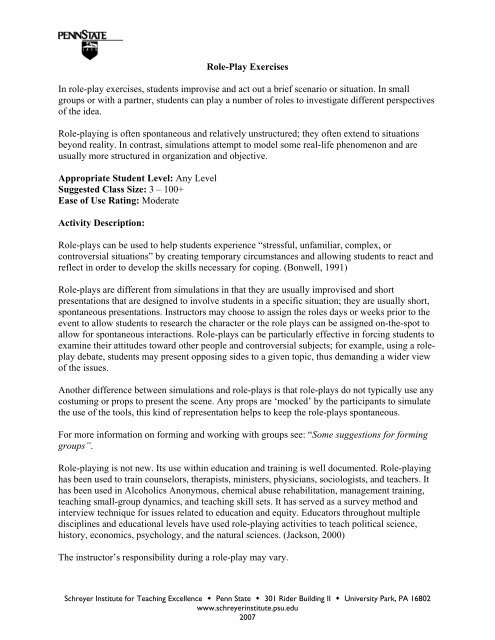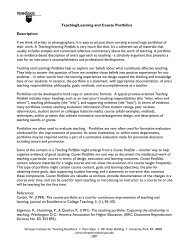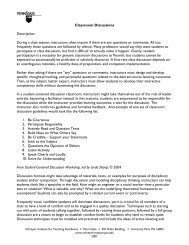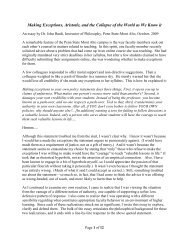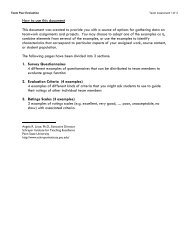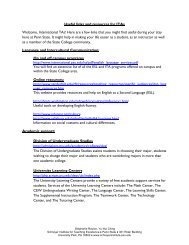Role-play exercises - Schreyer Institute for Teaching Excellence
Role-play exercises - Schreyer Institute for Teaching Excellence
Role-play exercises - Schreyer Institute for Teaching Excellence
Create successful ePaper yourself
Turn your PDF publications into a flip-book with our unique Google optimized e-Paper software.
<strong>Role</strong>-Play Exercises<br />
In role-<strong>play</strong> <strong>exercises</strong>, students improvise and act out a brief scenario or situation. In small<br />
groups or with a partner, students can <strong>play</strong> a number of roles to investigate different perspectives<br />
of the idea.<br />
<strong>Role</strong>-<strong>play</strong>ing is often spontaneous and relatively unstructured; they often extend to situations<br />
beyond reality. In contrast, simulations attempt to model some real-life phenomenon and are<br />
usually more structured in organization and objective.<br />
Appropriate Student Level: Any Level<br />
Suggested Class Size: 3 – 100+<br />
Ease of Use Rating: Moderate<br />
Activity Description:<br />
<strong>Role</strong>-<strong>play</strong>s can be used to help students experience “stressful, unfamiliar, complex, or<br />
controversial situations” by creating temporary circumstances and allowing students to react and<br />
reflect in order to develop the skills necessary <strong>for</strong> coping. (Bonwell, 1991)<br />
<strong>Role</strong>-<strong>play</strong>s are different from simulations in that they are usually improvised and short<br />
presentations that are designed to involve students in a specific situation; they are usually short,<br />
spontaneous presentations. Instructors may choose to assign the roles days or weeks prior to the<br />
event to allow students to research the character or the role <strong>play</strong>s can be assigned on-the-spot to<br />
allow <strong>for</strong> spontaneous interactions. <strong>Role</strong>-<strong>play</strong>s can be particularly effective in <strong>for</strong>cing students to<br />
examine their attitudes toward other people and controversial subjects; <strong>for</strong> example, using a role<strong>play</strong><br />
debate, students may present opposing sides to a given topic, thus demanding a wider view<br />
of the issues.<br />
Another difference between simulations and role-<strong>play</strong>s is that role-<strong>play</strong>s do not typically use any<br />
costuming or props to present the scene. Any props are ‘mocked’ by the participants to simulate<br />
the use of the tools, this kind of representation helps to keep the role-<strong>play</strong>s spontaneous.<br />
For more in<strong>for</strong>mation on <strong>for</strong>ming and working with groups see: “Some suggestions <strong>for</strong> <strong>for</strong>ming<br />
groups”.<br />
<strong>Role</strong>-<strong>play</strong>ing is not new. Its use within education and training is well documented. <strong>Role</strong>-<strong>play</strong>ing<br />
has been used to train counselors, therapists, ministers, physicians, sociologists, and teachers. It<br />
has been used in Alcoholics Anonymous, chemical abuse rehabilitation, management training,<br />
teaching small-group dynamics, and teaching skill sets. It has served as a survey method and<br />
interview technique <strong>for</strong> issues related to education and equity. Educators throughout multiple<br />
disciplines and educational levels have used role-<strong>play</strong>ing activities to teach political science,<br />
history, economics, psychology, and the natural sciences. (Jackson, 2000)<br />
The instructor’s responsibility during a role-<strong>play</strong> may vary.<br />
<strong>Schreyer</strong> <strong>Institute</strong> <strong>for</strong> <strong>Teaching</strong> <strong>Excellence</strong> • Penn State • 301 Rider Building II • University Park, PA 16802<br />
www.schreyerinstitute.psu.edu<br />
2007
• Provide background details by giving specific in<strong>for</strong>mation about the character or the<br />
setting to help create the scene<br />
• Define the roles, characters or scenario<br />
• Discuss the goals and objectives of the activity to involve the audience and create a need to<br />
learn.<br />
• Facilitate and direct the role <strong>play</strong> to assure the goals are being met<br />
• Help the audience evaluate and summarize the major factors of the role-<strong>play</strong>.<br />
Assessment can be conducted in a number of ways. Students can be evaluated on their<br />
participation in the role <strong>play</strong>s and subsequent discussion, how effectively they can state their<br />
position, background knowledge, accuracy of in<strong>for</strong>mation presented and how effectively they<br />
defend their position<br />
“<strong>Role</strong>-<strong>play</strong>ing is a bridging educational model <strong>for</strong> the sciences. It spans the full scale from the<br />
interdependence that typifies industrial work and independent research (individuals in a group<br />
retain their individuality but agree to become mutually dependent in achieving a goal) to the<br />
partners approach that of necessity characterizes some of the beginning labs in the sciences. As a<br />
bridge, it allows students to explore management roles, specialist roles, and small-group<br />
communication dynamics, including how to reach a consensus without alienation. Students are<br />
encouraged to examine research or development work situations without the high risks that<br />
accompany the roles in the professional world. Students cannot be laid off from the course!”<br />
(Jackson, 2000)<br />
<strong>Role</strong>-Play Simulations in the Lesson Plan<br />
Lesson plans using role <strong>play</strong> and focusing on an aesthetic dilemma typically include four<br />
steps:<br />
1. Introduction. Teachers introduce a particular aesthetic concept, <strong>for</strong> example, some aspect<br />
of beauty, censorship, or interpretation. A scenario containing an aesthetic dilemma<br />
focusing on that concept is described.<br />
2. Small-group work. Guided by open-ended questions students have an opportunity to<br />
explore different points of view and discuss how particular interested parties might react<br />
in the dilemma. In one class period, teachers assign roles to small groups. The group<br />
helps one member prepare to <strong>play</strong> "their" character by developing arguments and<br />
supportive evidence. It is conceivable that small-group activities be bypassed if students<br />
seem prepared to improvise roles or if limited time is available.<br />
3. Large-group work. <strong>Role</strong>-<strong>play</strong> characterization is introduced here. <strong>Role</strong>s could be assigned<br />
at this point, or previously arranged roles discussed in the small groups could be <strong>play</strong>ed<br />
out. The audience may participate if their input would be advantageous.<br />
4. Conclusion. Students benefit from a chance to internalize the class activity by reviewing<br />
how the discussion and role <strong>play</strong> related to the original concept. Responding to questions<br />
at the end of class either through a journal or class discussion is helpful.” (Venable, 2001)<br />
<strong>Schreyer</strong> <strong>Institute</strong> <strong>for</strong> <strong>Teaching</strong> <strong>Excellence</strong> • Penn State • 301 Rider Building II • University Park, PA 16802<br />
www.schreyerinstitute.psu.edu<br />
2007
References:<br />
Bonwell, Charles C. and Eison, James A.(1991) Active Learning: Creating excitement in the<br />
Classroom. ASHE-ERIC Higher Education Report No.1<br />
Eyler, Janet (2000)”Focusing student inquiry; The beanbag press conference” College <strong>Teaching</strong>,<br />
48(2), p. 61<br />
Halpern, Daine F. (1994) Changing College Classrooms, Jossey-Bass, San Francisco<br />
Jackson, Paul T; (2000) “<strong>Role</strong>-<strong>play</strong>ing in analytical chemistry: The alumni speak” Journal of<br />
Chemical Education, 77(8); pg. 1019<br />
Lowry, Pamela E. (1999) “Model GATT: A role-<strong>play</strong>ing simulation course” The Journal of<br />
Economic Education 30(2)<br />
McCarthy, J. Patrick (2000) “Active learning techniques versus traditional teaching styles: two<br />
experiments from history and political science” Innovative Higher Education 24(4), p. 279<br />
Meyers, Chet and Jones, Thomas B. (1993) Promoting Active Learning: Strategies <strong>for</strong> the<br />
College Classroom. Jossey-Bass, San Francisco<br />
Venable, Brad<strong>for</strong>d B. (2001) “Using role <strong>play</strong> to teach and learn aesthetics”, Art Education,<br />
54(1); pg. 47<br />
The Core Competencies are:<br />
1. Writing, speaking and/or other <strong>for</strong>ms of self-expression<br />
3. Synthesis and analysis in problem solving and critical thinking, including, where<br />
appropriate, the application of reasoning and interpretive methods, and quantitative<br />
thinking<br />
4. Collaborative learning and teamwork<br />
5. Activities that promote and advance intercultural and/or international understanding<br />
7. A significant alternative competency <strong>for</strong> active learning designed <strong>for</strong> and appropriate to a<br />
specific course<br />
<strong>Schreyer</strong> <strong>Institute</strong> <strong>for</strong> <strong>Teaching</strong> <strong>Excellence</strong> • Penn State • 301 Rider Building II • University Park, PA 16802<br />
www.schreyerinstitute.psu.edu<br />
2007


